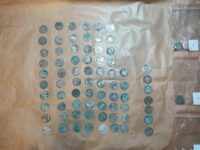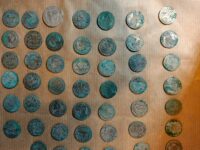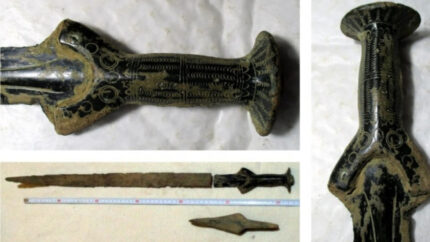It has been a fruitful mushroom-picking season in Eastern Europe. On October 22nd, Bogusław Rumiński took his bike to go mushroom-picking in  his home village of Jezuicka Struga in north-central Poland. While riding along a bumpy road, the bike got stuck in a rut and Rumiński fell over. He put his arm out to break his fall and came up with a handful of six silver coins. When he looked around, he found 60 more of them scattered on the ground.
his home village of Jezuicka Struga in north-central Poland. While riding along a bumpy road, the bike got stuck in a rut and Rumiński fell over. He put his arm out to break his fall and came up with a handful of six silver coins. When he looked around, he found 60 more of them scattered on the ground.
He reported the find to the Provincial Office for the Protection of Monuments in Toruń who dispatched an employee to scan the find site the next day. Another seven coins were discovered. The day after that, archaeologists arrived on the scene to excavate. The dig turned up another 13 coins, bringing the total 86.
 The coins are all silver and date to the second half of the 17th century during the reign of King John II Casimir Vasa (r. 1648 – 1668). The oldest was minted in 1657, the youngest in 1667. They are in different denominations — mostly six-groszy coins, but also larger denominations including 18-groszy coins. They were minted at a turbulent time in the Polish-Lithuanian Commonwealth. The country was mired in the Russo-Polish War (1654-1667) and in the Swedish invasion known as The Deluge (1655-1660). While there is verdigris and other corrosion material on some of the coins, underneath that they look to be in excellent condition, close to mint. Because of this, archaeologists believe they were buried when they were new, likely hidden to keep them from becoming war booty.
The coins are all silver and date to the second half of the 17th century during the reign of King John II Casimir Vasa (r. 1648 – 1668). The oldest was minted in 1657, the youngest in 1667. They are in different denominations — mostly six-groszy coins, but also larger denominations including 18-groszy coins. They were minted at a turbulent time in the Polish-Lithuanian Commonwealth. The country was mired in the Russo-Polish War (1654-1667) and in the Swedish invasion known as The Deluge (1655-1660). While there is verdigris and other corrosion material on some of the coins, underneath that they look to be in excellent condition, close to mint. Because of this, archaeologists believe they were buried when they were new, likely hidden to keep them from becoming war booty.
The coins are now being conserved. When that is complete, they will join the collection of the Jan Kasprowicz Museum in Inowrocław.
Meanwhile, over in the Jesenicko district of Northern Moravia, Czech Republic, Roman Novák took advantage of ideal fungi-hunting weather after the rain to look for mushrooms in the woods near his home when he came across a piece of metal sticking out of some stones. He dug it up and found a sword. He dug some more and found a bronze axe.
Mr. Novák immediately contacted archaeologists who have since conducted several tests. These show that both the sword and axe date back to around 1,300 BC and resemble weapons used mainly in the area of what is today Northern Germany, says Jiří Juchelka, who leads the archaeology department at the nearby Silesian Museum.
“The sword has an octagonal handle. It is only the second sword of its type to be found here.”
Experts say they were surprised to find such a sword in the Jesenicko area, because, at the time, it was sparsely populated. However, tests on the soil show that it is indeed local.
It was made of bronze and cast in a mould rather than hammered like the much-stronger iron blades that followed them. The quality of the casting of this sword was fairly low. X-rays found the blade metal was replete with small bubbles which would have made it flimsy for combat. It may have been ceremonial or symbolic.
The find site will be archaeologically excavated and the sword and axe studied. When analysis is complete, the artifacts will be exhibited at the Ethnographic Museum of Jesenicko and the Silesian Museum.

Does anyone know why the sword is shiny black?
Natural patina or (artificial) ‘patination’:
:hattip:
“For copper alloys, such as bronze, exposure to chlorides leads to green, while sulfur compounds (such as “liver of sulfur”) tend to brown. The basic palette for patinas on copper alloys includes chemicals like ammonium sulfide (blue-black), liver of sulfur (brown-black), cupric nitrate (blue-green) and ferric nitrate (yellow-brown). For artworks, patination is often deliberately accelerated by applying chemicals with heat. Colors range from matte sandstone yellow to deep blues, greens, whites, reds and various blacks.”
The South West monsoon winds blowing over the Arabian Sea hit the Ghats bringing torrential rains to Goa on the western coast of India. Within weeks, forests and fields turn green. In the months of July and August, village folk in certain parts of Goa spend days and hours in the thick forests gathering wild mushrooms, a top seasonal Goan delicacy. But more than mushrooms, Goa has a rich history of migrations that one can study from the artifacts unearthed by local villagers. Archeologists, historians, anthropologists, and lovers of antiquity marvel at the rich deposits left behind by successive dynasties, empires, and ruling classes who were privileged to make Goa their home for centuries.
Pages of history have much to say about Goa’s past. Evidence of human life in Goa dates to 8000-6000 B.C. Rock carvings of the mother goddess deity near the Goan Kushavati river bear testimony to that historical fact. Scholars believe Mundari tribes may have been the earliest inhabitants of the region. The Sumerians arrived in Goa in 2200 B.C. The next wave of migrants entered Goa between 1700 to 1400 B.C. Later migrants were South Indians from the Deccan plateau. The Mauryas arrived and ruled Goa from the 4th to the 7th century B.C. Then came the Satavahanas, the vassals of the Mauryan Empire. Their rule lasted from 2nd century B.C. to 100 A.D.
The Bhojas were the next after the collapse of Satavahanas. During the Bhoja epoch, Greek traders who became converts to Buddhism settled in Goa. Several Buddha statues in Greek styles have been found in Goa. The Bhojas ruled Goa for more than 500 years. The earliest known record of the Bhojas in Goa dates from the 4th century A.D. It was found in the Shiroda constituency in Central Goa.
The Shilaharas ruled parts of Goa from 755 till 1000 A.D, followed by the Kadambas ruling Goa from the 10th to 14th century. The Goa State Bus Transport Corporation is named after the legendary Kadamba dynasty. In 1350 A.D. Goa was conquered by the Bahmani Sultans. In 1370, the Vijayanagara empire, re-conquered Goa and ruled for nearly a century. In 1469, Goa was re-conquered by the Bahmani Sultans of Gulbarga. When the Bahmani Sultanate broke up in 1492, Goa became a part of Adil Shah’s Bijapur Sultanate.
Overcoming the Bijapur rulers, Portugal added Goa to its Estado da India properties in 1510. The European rule lasted for about 450 years. In December 1961, Goa became part of the Indian Union. Artifacts, monuments, and statues keep surfacing in Goa all the time. The artistically illuminated Adil Shahi palace on the Mandovi river-front in Panaji, looks majestic during the Christmas and New year festivities.